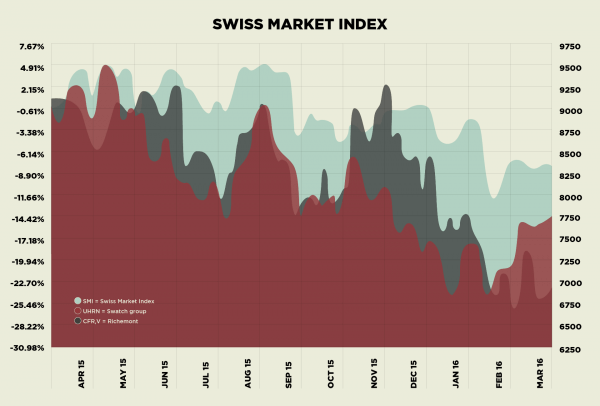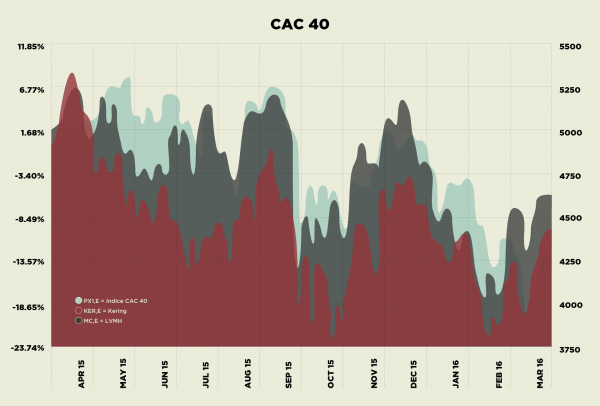Grist to the connected watch mill, Strategy Analytics has reported worldwide shipments of 8.1 million smartwatches for the final quarter 2015, compared with 7.9 million for Swiss watches. According to the research firm, this represents 316% growth on Q4 2014. Unsurprisingly, sales were dominated by Apple, which moved 5.1 million units, followed by Samsung with its 1.3 million units. The only Swiss who, like William Tell, has dared fire an arrow at the electronics giant and other smaller apples is Jean-Claude Biver – who else? – with his TAG Heuer Connected. Neil Mawston, Strategy Analytics’ insightful executive director, doesn’t mince his words: “Swiss watchmakers have been sticking their head in the sand hoping smartwatches will go away.” You can’t argue with that! Particularly as Swiss watch export figures for January confirm his line of thinking, having fallen 7.9% compared with January 2015, and this after losing 3.3% for the whole of last year. Hail, smartwatch!
If only analysis were that simple. Philippe Pegoraro, at the head of the economic and statistical department of the Federation of the Swiss Watch Industry, is unequivocal in his comment: “The fall in exports in 2015 can be explained by a complicated social and economic context which has affected the luxury industry in general.” Complicated indeed, with all due respect to Strategy Analytics and its black-and-white view. Just look at Apple’s results. Or rather lack of. More to the point, the lack of transparency in revealing said results. It hasn’t escaped attention that the Cupertino firm, which can blow its own horn better even than Louis Armstrong, hasn’t released precise sales figures for its smartwatch. Given that it can sell ten million iPhone 6 in one weekend, the roughly five million Apple Watches to have staggered off the shelves in three months pales in comparison. A quick search of the internet confirms that “the most personal device ever created” by the multinational isn’t driving sales as expected, considering the avalanche of criticism it has drawn. Let’s see what happens when the new version, slated for this year, is released.

Good days, bad days
On the subject of results, over the past weeks the watch industry’s giants have been releasing their latest financial information. Some examples: Swatch Group reports net sales of CHF 8.5 billion, which is 0.9% lower than the previous year; however, calculated in euros, the Group grew 10.3%. A chalk-and-cheese situation caused by “extremely adverse” exchange rates. At Richemont, the first nine months of its current financial year to end December 2015 ended with sales increasing 11% to €8.7 billion, although at constant exchange rates the figure is just 1%. As for what Kering refers to as its “other luxury brands”, principally Boucheron, Girard-Perregaux, Pomellato and Ulysse Nardin, revenue progressed by 20% in 2015 to €1.7 billion. The watch and jewelry division at LVMH, whose portfolio includes Bulgari, Chaumet, Hublot, TAG Heuer and Zenith, reported a similar increase in revenue in 2015 at 18.9%, rising to €3.3 billion.
The industry is still punching even though some would have it clinging to the ropes. Granted, not all news is good news, beginning with the situation in Hong Kong, Swiss watchmakers’ biggest market where exports plummeted 33% in January, having already lost 23% in 2015.

Richemont’s announcement of cuts in its workforce – shedding 350 of its 9,000 jobs in Switzerland with a view to “adjusting the production capacities of some watch manufacturers” – casts a shadow on brands’ own doorstep, although this is alleviated by the recent agreement between the same Richemont and the Jura Chamber of Agriculture regarding an extension to Cartier’s production facilities, which will create 200 new jobs. Even Corum, now in Chinese hands, finally has its head above water. The brand, thought to have hit rock bottom, is “no longer on life support”, in the words of Chief Operating Officer Davide Traxler, interviewed by Swiss daily Le Temps. For others, such as Audemars Piguet or Bulgari, it’s full steam ahead. While no-one is pretending the situation is perfect, given redundancies at a number of companies and difficulties faced by suppliers downstream, some brands are clearly weathering crisis more easily than others. And this has nothing to do with smartwatches.













